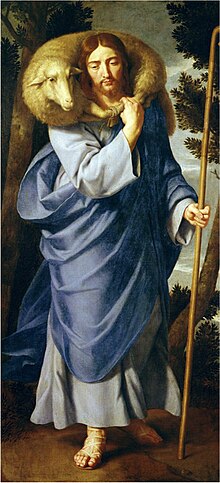Loading AI tools
Church cantata by Johann Sebastian Bach From Wikipedia, the free encyclopedia
Ich bin ein guter Hirt (I am a Good Shepherd),[1] BWV 85, is a church cantata by Johann Sebastian Bach. He composed it in Leipzig for the second Sunday after Easter and first performed it on 15 April 1725.
| Ich bin ein guter Hirt | |
|---|---|
BWV 85 | |
| Church cantata by J. S. Bach | |
 | |
| Occasion | Second Sunday after Easter |
| Bible text | John 10:11 |
| Chorale |
|
| Performed | 14 April 1725: Leipzig |
| Movements | 6 |
| Vocal | SATB solo and choir |
| Instrumental |
|
Bach composed the cantata in his second annual cycle in Leipzig for the second Sunday after Easter, called Misericordias Domini. The prescribed readings for that Sunday were from the First Epistle of Peter, Christ as a model (1 Peter 2:21–25), and from the Gospel of John, the Good Shepherd (John 10:11–16).[2]
According to John Eliot Gardiner, the poet is likely the same as for two preceding cantatas, Bleib bei uns, denn es will Abend werden, BWV 6, and Am Abend aber desselbigen Sabbats, BWV 42,[3] before Christiana Mariana von Ziegler became the poet for the following cantatas of the period.[4] The three cantata texts were probably written for Bach's first year in Leipzig, but postponed due to the workload of the first performance of the St John Passion that year. They are a sequence on themes from the Gospel of John.[3] The poet opens the cantata with the beginning from the Gospel, verse 11.[5] The second movement explains that being a Good Shepherd was realized in the Passion. The thought is commented by the first stanza of Cornelius Becker's hymn "Der Herr ist mein getreuer Hirt" (1602),[6] a paraphrase of Psalm 23.[3] The poet refers in movement 4 to verse 12 of the Gospel, the contrast of the shepherd who is awake to watch over the sheep, whereas the hired servants sleep and neglect them. Movement 5 names love as the shepherd's motivation to care for the sheep. The cantata ends with the chorale "Ist Gott mein Schutz und treuer Hirt", the fourth stanza of Ernst Christoph Homberg's hymn "Ist Gott mein Schild und Helfersmann" (1658).[2]
Bach first performed the cantata on 15 April 1725.[2]
The cantata in six movements is scored for four vocal soloists (soprano, alto, tenor and bass), a four-part choir only in the chorale, two oboes, two violins, viola, violoncello piccolo and basso continuo.[2]
In the first movement, the bass as the vox Christi sings "I am a good shepherd", framed by instrumental ritornellos. The motif on these words appears already four times in the ritornello.[7] The movement is between aria and arioso, with the oboe as a concertante instrument in "a mood of tranquil seriousness".[5] The alto aria is accompanied by an obbligato violoncello piccolo.[5] The chorale stanza is sung by the soprano on the tune of "Allein Gott in der Höh sei Ehr" by Nikolaus Decius,[8] with a slightly ornamented melody, whereas the two oboes play a theme in ritornellos which is derived from the first line of the tune.[2]
The only recitative is a miniature sermon, accompanied by the strings accenting phrases of the text. Movement 5 is the only movement in the cantata in pastorale rhythm. The strings, violins and viola's, play in unison, so in the low register. Thus the tenor voice frequently appears as the highest part, beginning with three times "Seht" (look). Gardiner observes the similarity to an alto aria (movement 60) of the St Matthew Passion, Sehet, Jesus hat die Hand", similarities in both the theme "pastoral love emanating from the cross", and the music, described as "rich, flowing melody and gently rocking rhythm". The closing chorale is a four-part setting.[2][7]
Seamless Wikipedia browsing. On steroids.
Every time you click a link to Wikipedia, Wiktionary or Wikiquote in your browser's search results, it will show the modern Wikiwand interface.
Wikiwand extension is a five stars, simple, with minimum permission required to keep your browsing private, safe and transparent.